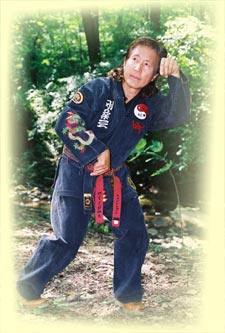By James Halladay

By James Halladay

Shaolin Do is a massive collection of styles which descended from the Shaolin Temple system in China, passed down from master to student and from generation to generation. These fighting arts encompass the most effective and devastating techniques developed by man, and they have survived the centuries because they work!

The basic elements which can be found in virtually any other martial arts style are encompassed within the Shaolin Do system. Thus, Shaolin Do is a comprehensive school of martial arts which interweaves diverse qualities into an action process of total harmony and effectiveness.
Shaolin Do requires of the student a strict code of physical and mental discipline not typically found in Western Culture. Such discipline must come from within oneself, driven by a deep desire to learn and forged through dedicated training and practice. It cannot be purchased in the price of lessons, nor forced on the student by the instructor.
In the beginning, basic prearranged forms called katas are learned. These become more complex as the student progresses and are designed to teach the subconscious mind how to control the body movements without conscious thought. Regardless of the style of martial art studied, the first year's basics are relatively universal. The fundamentals of punches, kicks, strikes, blocks, and stances are required to build a solid foundation before advanced material can be taught. But Shaolin Do is more than an effective fighting style. It teaches one when to fight and when not to fight. It becomes a way of life and a way of dealing with the struggles in life.
The most important battles are with oneself, in restraining the ego and developing control over one's body and mind. If you study Shaolin Do and learn only how to fight, you are not Shaolin. Shaolin Do provides the tools to make one a more rounded human being and teaches one how to avoid conflict.
The strength of a Shaolin Do practitioner lies in his ability to overcome impossible odds and difficult situations. The philosophy of Shaolin Do resides in balance, balance in life and balance in the arts. Thus, it is pointless to argue whether a soft or a hard style is better. Strength and balance lie in the coexistence of opposites and neither can exist without the other.
As the Yin-Yang symbol suggests, even the hardest style must have a soft core and the softest style must have a hard core. The most effective styles combine the elements from each extreme to create a graceful and fluid form of power.
Throughout its history, the Shaolin Temple was more of an idea and a way of life than it was a collection of buildings. While the buildings were burned and rebuilt many times, the idea never died. It lives on through the lives of each practitioner whom it has influenced. Each student becomes a part of that heritage.
It is also important to understand what Shaolin Do is not. Shaolin Do is not a religious practice in itself. While it originated in Buddhist and Taoist temples, the religious aspects were divorced from the martial arts framework at the temples. The religious teachings added a moral code of ethics to temper the unrestrained use of such knowledge. Shaolin Do is equally compatible with any religious teachings which emphasize tolerance, compassion and restraint. The use of force should always be considered a last resort, to be used only in the defense of oneself or of another. Shaolin Do does not replace formal education and schooling. The monks at the temples were knowledgeable in reading, writing, poetry, medicine, farming, and building in addition to the fighting arts. A good student of Shaolin Do will put forth the same effort at learning in school as in martial arts in order to be a well-rounded individual.
About the author: James Halladay is a student of Grandmaster Thé. He has been studying Shaolin Do since 1972 and he teaches in Erie, Pennsylvania.